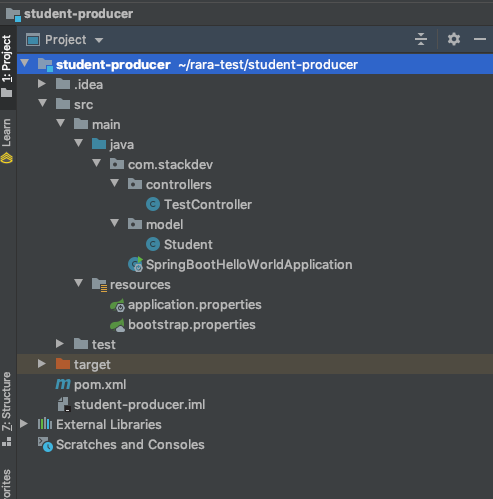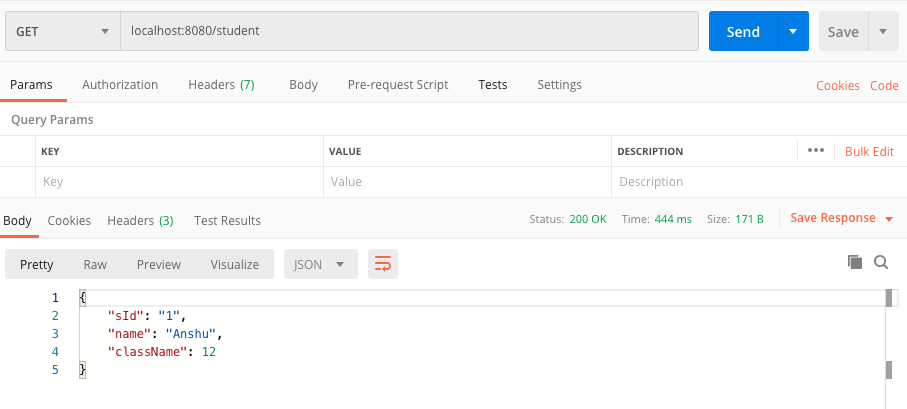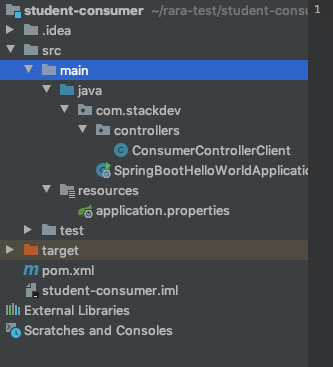This is the second article in a series of 5 articles covering service discovery in microservices architecture using SpringBoot and Netflix Eureka:
Part 1 - Overview of Netflix components.
THIS - Develop an Student service to produce and consume REST API using Spring Boot
Part 3 - Use Eureka for Service Registration
Part 4 - Use Eureka for Service Discovery
Part 5 - Load balancing using Netflix Eureka + Ribbon
In this post, we will be creating 2 services - student producer and student consumer. As the name suggests, the student-producer will be exposing REST APIs which will be consumed by the student-consumer.
So, let’s start with student producer. The maven project structure will look like this-

Add these spring dependencies in the pom.xml file:
<?xml version="1.0" encoding="UTF-8"?>
<project xmlns="http://maven.apache.org/POM/4.0.0"
xmlns:xsi="http://www.w3.org/2001/XMLSchema-instance"
xsi:schemaLocation="http://maven.apache.org/POM/4.0.0 http://maven.apache.org/xsd/maven-4.0.0.xsd">
<modelVersion>4.0.0</modelVersion>
<groupId>org.example</groupId>
<artifactId>student-producer</artifactId>
<version>1.0-SNAPSHOT</version>
<parent>
<groupId>org.springframework.boot</groupId>
<artifactId>spring-boot-starter-parent</artifactId>
<version>1.4.1.RELEASE</version>
<relativePath /> <!-- lookup parent from repository -->
</parent>
<properties>
<project.build.sourceEncoding>UTF-8</project.build.sourceEncoding>
<project.reporting.outputEncoding>UTF-8</project.reporting.outputEncoding>
<java.version>1.8</java.version>
</properties>
<dependencies>
<dependency>
<groupId>org.springframework.boot</groupId>
<artifactId>spring-boot-starter-web</artifactId>
</dependency>
<dependency>
<groupId>org.springframework.boot</groupId>
<artifactId>spring-boot-starter-test</artifactId>
<scope>test</scope>
</dependency>
</dependencies>
<build>
<plugins>
<plugin>
<groupId>org.springframework.boot</groupId>
<artifactId>spring-boot-maven-plugin</artifactId>
</plugin>
</plugins>
</build>
</project>
Create the model class Student:
package com.stackdev.model;
public class Student {
private String sId;
private String name;
private Integer className;
public Student() {
}
public String getName() {
return name;
}
public void setName(String name) {
this.name = name;
}
public Integer getClassName() {
return className;
}
public void setClass(Integer className) {
this.className = className;
}
public String getsId() {
return sId;
}
public void setsId(String sId) {
this.sId = sId;
}
}
Create the controller as:
package com.stackdev.controllers;
import org.springframework.web.bind.annotation.RequestMapping;
import org.springframework.web.bind.annotation.RequestMethod;
import org.springframework.web.bind.annotation.RestController;
import com.stackdev.model.Student;
@RestController
public class TestController {
@RequestMapping(value = "/student", method = RequestMethod.GET)
public Student firstPage() {
Student s = new Student();
s.setName("emp1");
s.setClass(12);
s.setsId("1");
return s;
}
}
The SpringBootHelloWorldApplication main class will look like this:
package com.stackdev;
import org.springframework.boot.SpringApplication;
import org.springframework.boot.autoconfigure.SpringBootApplication;
import org.springframework.cloud.client.discovery.EnableDiscoveryClient;
@SpringBootApplication
@EnableDiscoveryClient
public class SpringBootHelloWorldApplication {
public static void main(String[] args) {
SpringApplication.run(SpringBootHelloWorldApplication.class, args);
}
}
Now compile and run the application. Go to localhost:8080/student You will see the response:

Now, we’ll create student-consumer project. The project structure will look like this:

Add the following dependancies in the pom.xml file:
<?xml version="1.0" encoding="UTF-8"?>
<project xmlns="http://maven.apache.org/POM/4.0.0"
xmlns:xsi="http://www.w3.org/2001/XMLSchema-instance"
xsi:schemaLocation="http://maven.apache.org/POM/4.0.0 http://maven.apache.org/xsd/maven-4.0.0.xsd">
<modelVersion>4.0.0</modelVersion>
<groupId>org.example</groupId>
<artifactId>student-consumer</artifactId>
<version>1.0-SNAPSHOT</version>
<parent>
<groupId>org.springframework.boot</groupId>
<artifactId>spring-boot-starter-parent</artifactId>
<version>1.4.1.RELEASE</version>
<relativePath /> <!-- lookup parent from repository -->
</parent>
<properties>
<project.build.sourceEncoding>UTF-8</project.build.sourceEncoding>
<project.reporting.outputEncoding>UTF-8</project.reporting.outputEncoding>
<java.version>1.8</java.version>
</properties>
<dependencies>
<dependency>
<groupId>org.springframework.boot</groupId>
<artifactId>spring-boot-starter-web</artifactId>
</dependency>
<dependency>
<groupId>org.springframework.boot</groupId>
<artifactId>spring-boot-starter-test</artifactId>
<scope>test</scope>
</dependency>
</dependencies>
<build>
<plugins>
<plugin>
<groupId>org.springframework.boot</groupId>
<artifactId>spring-boot-maven-plugin</artifactId>
</plugin>
</plugins>
</build>
</project>
Define the controller to consume the service exposed by student-producer above using the REST Template as follows-
import java.io.IOException;
import org.springframework.http.HttpEntity;
import org.springframework.http.HttpHeaders;
import org.springframework.http.HttpMethod;
import org.springframework.http.MediaType;
import org.springframework.http.ResponseEntity;
import org.springframework.web.client.RestClientException;
import org.springframework.web.client.RestTemplate;
@RequestMapping(value = "/student/consumer", method = RequestMethod.GET) public String getStudent() throws RestClientException, IOException {
String baseUrl = "http://localhost:8080/student";
RestTemplate restTemplate = new RestTemplate();
ResponseEntity<String> response=null;
try{
response=restTemplate.exchange(baseUrl,
HttpMethod.GET, getHeaders(),String.class);
}catch (Exception ex)
{
System.out.println(ex);
}
System.out.println(response.getBody());
}
private static HttpEntity<?> getHeaders() throws IOException {
HttpHeaders headers = new HttpHeaders();
headers.set("Accept", MediaType.APPLICATION_JSON_VALUE);
return new HttpEntity<>(headers);
}
}
Finally create the Bean for the above controller, load it and call the getStudent() Method.
package com.stackdev;
import java.io.IOException;
import org.springframework.boot.SpringApplication;
import org.springframework.boot.autoconfigure.SpringBootApplication;
import org.springframework.context.ApplicationContext;
import org.springframework.context.annotation.Bean;
import org.springframework.web.client.RestClientException;
import com.stackdev.controllers.ConsumerControllerClient;
@SpringBootApplication
public class SpringBootHelloWorldApplication {
public static void main(String[] args) throws RestClientException, IOException {
ApplicationContext ctx = SpringApplication.run(
SpringBootHelloWorldApplication.class, args);
ConsumerControllerClient consumerControllerClient=ctx.getBean(ConsumerControllerClient.class);
System.out.println(consumerControllerClient);
consumerControllerClient.getStudent();
}
@Bean
public ConsumerControllerClient consumerControllerClient()
{
return new ConsumerControllerClient();
}
}
Now run the application. Check the console for the response:

In the next post we will develop a Eureka Server microservice using Spring Boot and register our student-producer service to it.